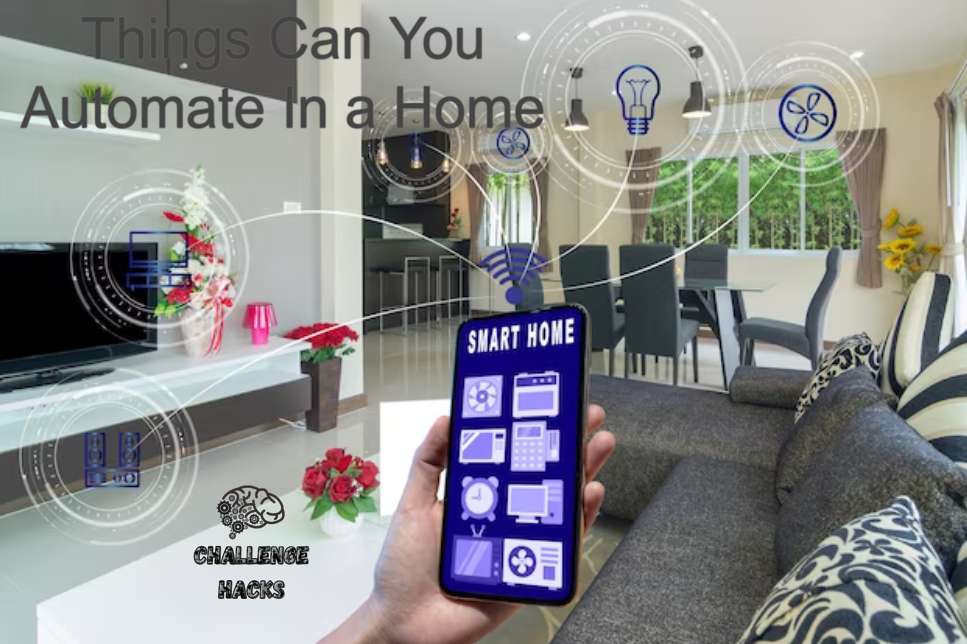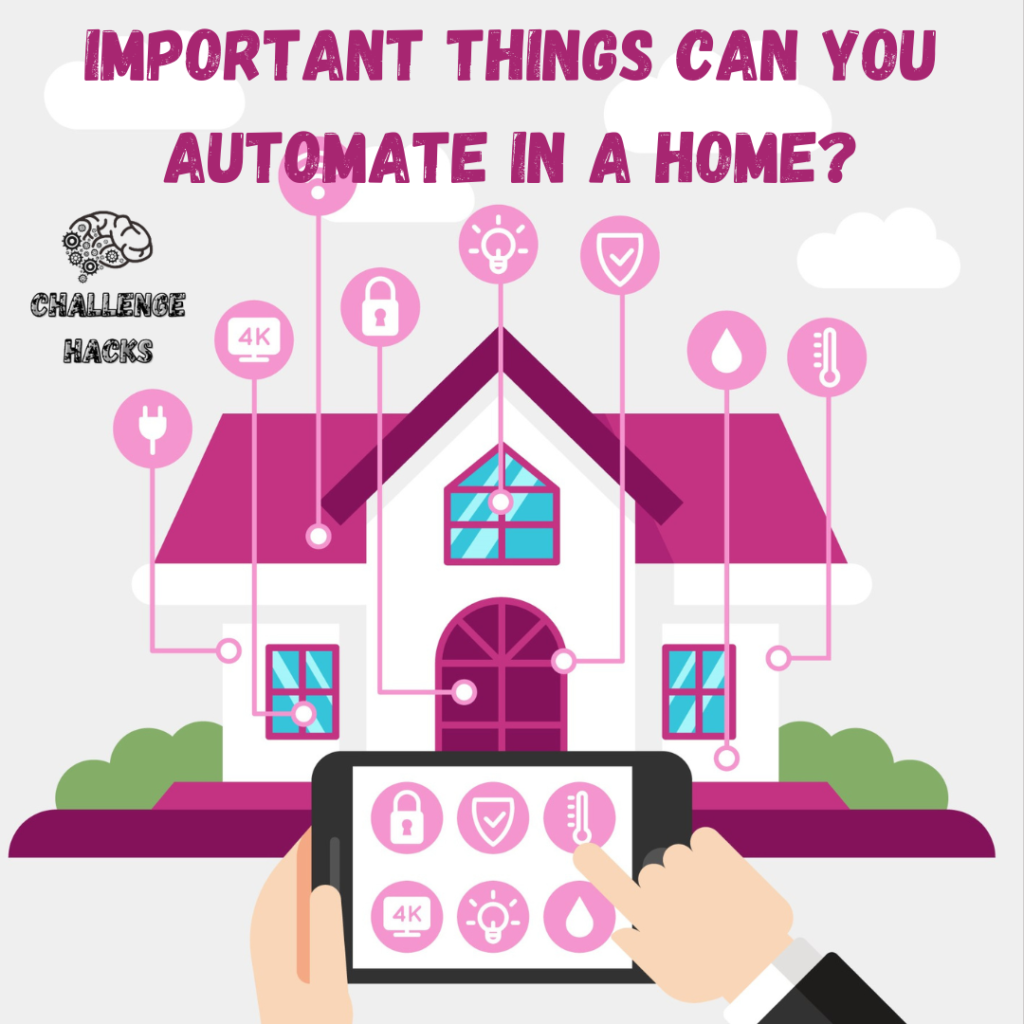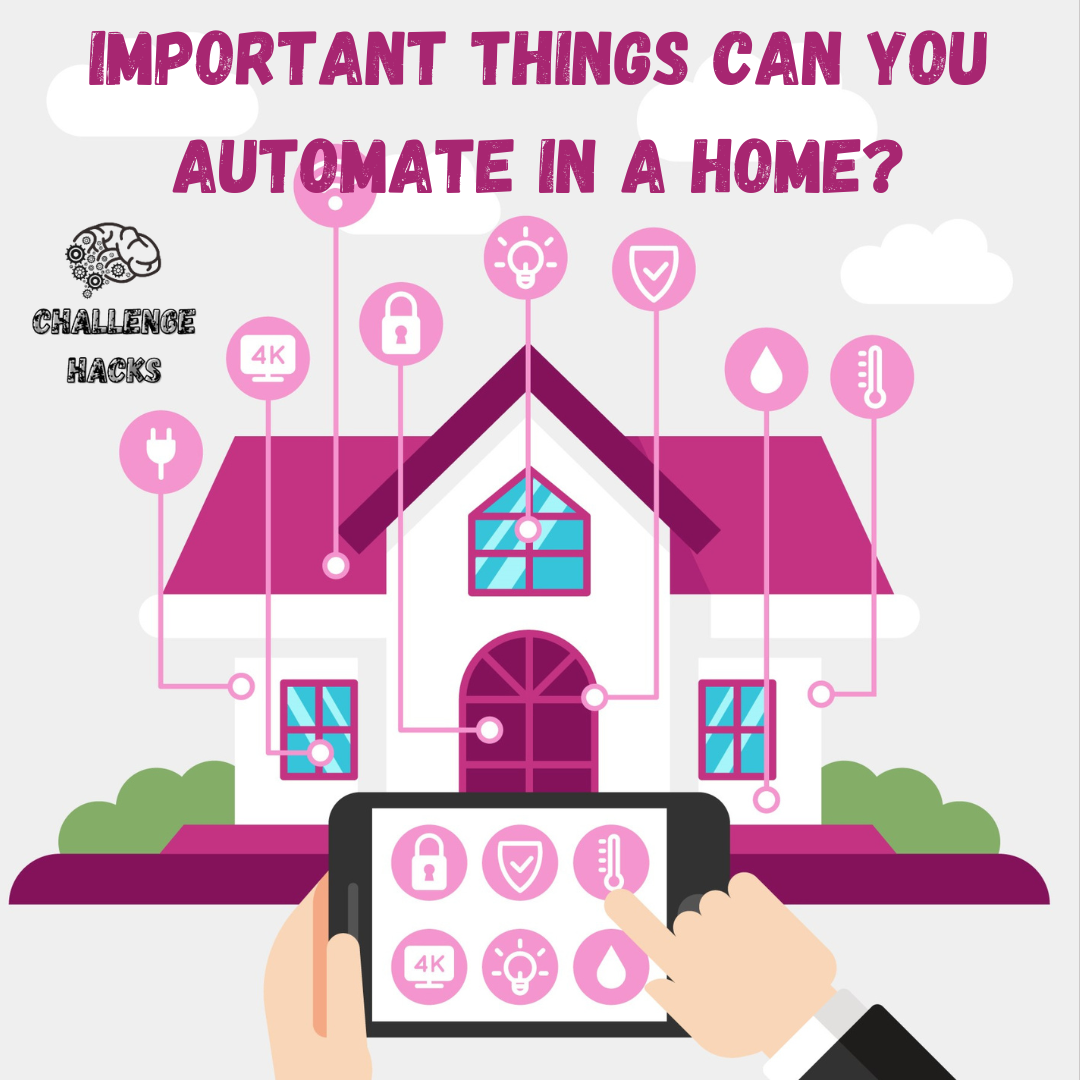
Home automation, often likened to wielding magic in your own home, empowers you to control lighting, climate, security, entertainment, and more with the wave of a smart device. It opens doors to a world of advantages, from sheer convenience to enhanced safety, energy savings, and accessibility. Yet, like any enchanting journey, it’s not without its challenges.
The cost, compatibility, reliability, security, and privacy issues cast a shadow over this digital realm. In this narrative, we’ll not only uncover the spells that Things Can You Automate In a Home task but also navigate the twists and turns of this modern magic, weighing its charms and cautions.
Table of Contents
Important Things Can You Automate In a Home

Lighting Control
One of the most common and basic Things Can You Automate In a Home is lighting control. Lighting control allows you to adjust the brightness, color, and timing of your lights using smart switches, smart bulbs, smart plugs, or smart hubs. You can also use voice commands, motion sensors, or schedules to turn your lights on or off automatically. Some examples of lighting control are:
- You can set your lights to turn on at sunset or off at sunrise.
- You can dim your lights or change their color to create different moods or scenes.
- You can have your lights flash or change color when someone rings the doorbell or when you receive a notification on your phone.
- You can have your lights turn off when you leave the house or turn on when you arrive home using geofencing.
- You can have your lights wake you up in the morning by gradually increasing their brightness.
Pros of Lighting Control
Lighting control can offer several advantages, such as: (Things Can You Automate In a Home)
- It can save energy and money by reducing unnecessary lighting usage.
- It can enhance your comfort and convenience by allowing you to control your lights from anywhere or without touching a switch.
- It can improve your security by making it look like someone is home when you are away or by alerting you to potential intruders.
- It can add fun and creativity to your home by creating different atmospheres or effects with your lights.
Cons of Lighting Control
Lighting control can also have some drawbacks, such as: (Things Can You Automate In a Home)
- It can be expensive to install and maintain smart lighting devices and systems.
- It can be incompatible with some existing fixtures or wiring in your home.
- It can be unreliable or slow if your internet connection or power supply is interrupted or if your devices malfunction.
- It can pose security and privacy risks if your devices are hacked or accessed by unauthorized users.
Climate Control
Climate management is a pivotal component of home automation. Smart devices such as thermostats, air conditioners, heaters, fans, and humidifiers empower you to oversee your home’s temperature and humidity. You can even automate these systems using schedules, sensors, or geofencing to cater to your climate preferences. Here are some instances of climate control:
- Optimize energy usage by programming your smart thermostat to lower temperatures during the night or when you’re away.
- Improve air quality and comfort by activating your smart fan when the temperature rises or air quality declines.
- Enhance efficiency by turning off your smart air conditioner when a window is open or the room is unoccupied.
- Stay cozy and conserve energy by activating your smart heater when the temperature drops or when a room is occupied.
- Promote healthier living conditions by turning on your smart humidifier when humidity is low or when someone’s health requires it.
Pros of Climate Control
Climate control offers various advantages, such as: (Things Can You Automate In a Home)
- By using less energy and money for unneeded heating or cooling, it can save both.
- By enabling you to adjust your climate remotely or without using a device, it can improve your comfort and convenience.
- Keeping your home at the ideal temperature and humidity levels can enhance your health and well-being.
- It can shield your possessions and house from harm brought on by high humidity or heat.
Cons of Climate Control
Climate control can also have some drawbacks, such as: (Things Can You Automate In a Home)
- It can be expensive to install and maintain smart climate devices and systems.
- It can be incompatible with some existing HVAC systems or appliances in your home.
- It can be unreliable or slow if your internet connection or power supply is interrupted or if your devices malfunction.
- It can pose security and privacy risks if your devices are hacked or accessed by unauthorized users.
Security and Safety
Other essential elements of a house that can be automated include safety and security. You can monitor and protect your home from hazards like fire, water, gas, or intruders with the use of smart cameras, locks, alarms, sensors, or hubs. More choices for monitoring your home and taking appropriate action include notifications, live feeds, and remote access. Instances of safety and security include the following:
- When your camera senses activity or sounds in your house, it can be configured to record video or take pictures.
- With geofencing, you can program your lock to unlock as soon as you approach the door or to lock when you leave the house.
- You can program your alarm to go off if it senses a water leak, glass break, smoke, or carbon monoxide in your house.
- Your sensor can be configured to notify you if it senses a vibration, a change in temperature, or the opening of a door or window in your house.
- Your hub can be configured to manage all of your safety and security systems and equipment and to notify you or issue alerts in the event of an incident.
Pros of Security and Safety
Numerous benefits can result from security and safety, including: (Things Can You Automate In a Home)
- Through the detection or prevention of possible risks within your house, it can save lives and property.
- It can increase your convenience and peace of mind by enabling you to watch and manage your house from any location or without using a gadget.
- It lowers the chance of theft, fire, water damage, and other claims, which can raise your insurance costs.
- It can increase the value of your house by enhancing its appeal to potential tenants or buyers.
Cons of Security and Safety
There are several disadvantages to security and safety as well, such as: (Things Can You Automate In a Home)
- Installing and maintaining smart safety and security systems can be costly.
- It might not work with certain of the safety or security systems or appliances you currently have in your house.
- If your equipment malfunctions, your internet connection is interrupted, or your power supply is interrupted, it may be erratic or slow.
- If someone gains illegal access to your devices or hacks into them, there may be security and privacy concerns.
Entertainment and Media
Media and entertainment are significant additional home automation tasks. Through the use of smart speakers, smart TVs, smart projectors, smart remotes, or smart hubs, you may experience a variety of audiovisual content, including music, movies, shows, games, podcasts, and news. To operate your entertainment and media systems and gadgets, you can also utilize voice commands, scheduling, or scenes. Among the media and entertainment examples are:
- You can set your speaker to play music from your favorite playlist or streaming service using voice commands.
- You can set your TV to turn on at a certain time or channel using schedules.
- You can set your projector to display images or videos from your phone or laptop using a wireless connection.
- You can set your remote to control all your entertainment and media devices and systems using one device.
- You can set your hub to create scenes that combine different entertainment and media devices and systems for different occasions.
Pros of Entertainment and Media
Media and entertainment can provide several benefits, including: (Things Can You Automate In a Home)
- By eliminating the need for numerous devices or subscriptions to various content providers, it can save time and money.
- By enabling you to manage your media and entertainment from any location or without having to touch a device, it can increase your convenience and enjoyment.
- By offering you a variety of entertaining and informative options that are tailored to your tastes and requirements, it can elevate your mood and general well-being.
- Modifying the lighting, sound, and graphics in your house based on the content you’re watching or listening to, can improve the ambiance there.
Cons of Entertainment and Media
Entertainment and media, despite their allure, come with potential downsides: (Things Can You Automate In a Home)
- Setting up and keeping smart entertainment and media systems can strain your finances due to initial costs and ongoing maintenance expenses.
- Incompatibility issues may arise with existing entertainment devices or media formats in your home, potentially limiting your options.
- The reliability of these systems may waver when internet interruptions, power outages, or device glitches occur, affecting your seamless experience.
- Smart entertainment and media can expose you to security and privacy risks when unauthorized access or hacking incidents compromise your personal space and data.
Other Smart Devices and Systems
Besides the above-mentioned things, there are many other smart devices and systems that Things Can You Automate In a Home. Some examples are: (Things Can You Automate In a Home)
| Smart Device/System | Function |
|---|---|
| Smart Vacuum | Cleans the floor automatically |
| Smart Coffee Maker |

10 Tips for Making Money with Home Automation
What is home automation?
Home automation is the use of technology to control and manage various aspects of your home, such as lighting, temperature, security, entertainment, and appliances. You can use devices such as smart speakers, sensors, cameras, thermostats, plugs, switches, and hubs to connect and communicate with your home systems and devices. You can also use voice commands, mobile apps, or web interfaces to remotely monitor and control your home automation devices. (Things Can You Automate In a Home)
What are the benefits of home automation?
Home automation can offer many benefits, such as:
Saving time, energy, money, and hassle by automating tasks that you would normally do manually, such as turning on/off lights, adjusting the thermostat, locking/unlocking doors, etc.
Enhancing comfort, safety, and fun by creating personalized scenes and routines that suit your preferences and needs, such as waking up to your favorite music, setting the mood for a movie night, or receiving alerts when someone is at your door.
Expand your options and possibilities by integrating various devices and services that work together to create a smart home ecosystem, such as playing music from different sources, controlling smart appliances with voice commands, or accessing online information and entertainment.
How do I get started with home automation?
Getting started with home automation is easier than ever before. Here are some steps you can follow to create your own smart home: (Things Can You Automate In a Home)
Identify your goals and needs: What do you want to automate in your home? Why do you want to automate it? How do you want to control it?
Research your options: What are the best devices for your goals and needs? What are their features and benefits? How do they compare in terms of price, quality, compatibility, and integration?
Choose your devices: Based on your research, pick the devices that suit your budget, preferences, and expectations. Make sure they are compatible with each other and with other services you use or plan to use.
Install your devices: Follow the instructions provided by the device manufacturers or service providers to install your devices. You may need some tools, wires, or adapters to connect your devices to your home network or power source. You may also need to download some apps or create some accounts to set up and configure your devices.
Enjoy your smart home: Once your devices are installed and configured, you can start using them to automate your home. You can also customize and optimize your devices to create scenes and routines that match your lifestyle and preferences. You can also explore new features and possibilities that your devices offer or discover new devices and services that you can add to your smart home ecosystem.
What are some examples of Things Can You Automate In a Home?
There are many Things Can You Automate In a Home, depending on your goals and preferences. Some examples are:
Lighting: You can use smart bulbs, plugs, switches, or sensors to automate your lighting based on time of day, presence, motion, or voice commands. You can also change the color and brightness of your lights to create a different ambiance.
Temperature: You can use smart thermostats or sensors to automate your heating and cooling based on schedule, weather, occupancy, or voice commands. You can also adjust the temperature of individual rooms or zones to optimize comfort and efficiency.
Security: You can use smart locks, cameras, alarms, or sensors to automate your security based on location, activity, or voice commands. You can also monitor and control your security devices from anywhere using your smartphone or web browser.
Entertainment: You can use smart speakers, TVs, sound systems, or streaming devices to automate your entertainment based on mood, occasion, or voice commands. You can also play music or videos from different sources or devices using a single interface or command.
Appliances: You can use smart plugs, switches, or sensors to automate your appliances based on schedule, usage, or voice commands. You can also control smart appliances such as coffee makers, ovens, refrigerators, or washing machines using voice commands or mobile apps.
How much does home automation cost? The cost of home automation depends on various factors, such as the type and number of devices you want to automate, the brand and quality of the devices you choose, the installation and maintenance costs involved, and the compatibility and integration of the devices with each other and with other services. Generally speaking,
The more devices you want to automate
The higher the initial cost
The lower the marginal cost
The higher the potential savings
The higher the brand and quality of the devices you choose
The higher the initial cost
The lower the maintenance cost
The higher the reliability and performance
The easier the installation and maintenance involved
The lower the initial cost
The lower the maintenance cost
The higher the convenience and flexibility
The better the compatibility and integration of the devices with each other and with other services
The lower the initial cost
The lower the maintenance cost
The higher the functionality and usability
You can start small with a single device or a simple kit that costs around $50-$100, or go big with a whole-house system that costs around $1000-$5000. You can also mix and match different devices from different brands that work together using a common platform or protocol. Ultimately, the cost of home automation depends on your personal preferences and needs.

1 thought on “Important 4 Things Can You Automate In a Home?”